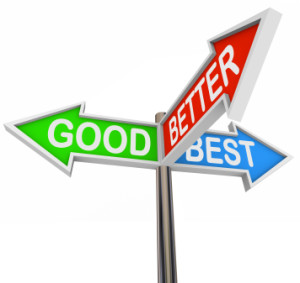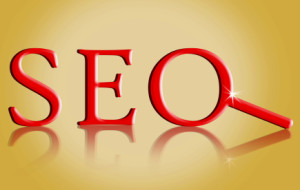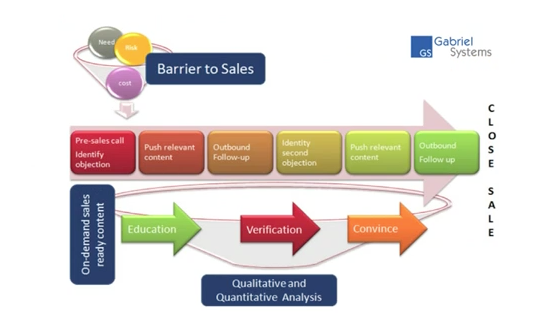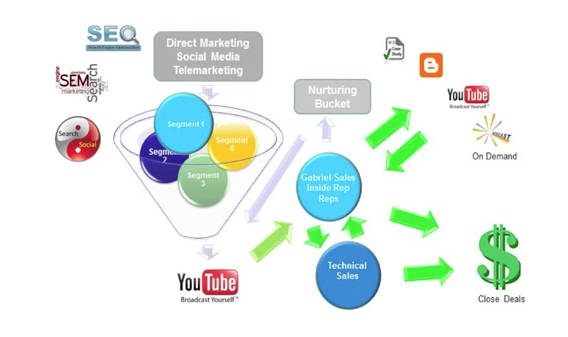by Glen Springer | Oct 27, 2013
 The following 7 underused B2B lead nurturing tactics are key areas where you can outwit your competition when nurturing leads (that your competitors are quite likely also nurturing). Don’t think you’re the only one a lead is talking to – even if you offer/service/product is the best in your industry – leads are going to leverage the angle of “talking to someone else, too”. So implement these following tactics to stay steps ahead of your competition while giving leads the best possible experience:
The following 7 underused B2B lead nurturing tactics are key areas where you can outwit your competition when nurturing leads (that your competitors are quite likely also nurturing). Don’t think you’re the only one a lead is talking to – even if you offer/service/product is the best in your industry – leads are going to leverage the angle of “talking to someone else, too”. So implement these following tactics to stay steps ahead of your competition while giving leads the best possible experience:
- Map your content to different stages in the buying cycle so that you know when to deliver content based on your lead’s activities.
- Analyze customers who you’ve recently transacted with and create a flowchart of how they moved through your content from initial interaction to purchase.
- Repurpose your content across various channels of consumption so your messaging is 1) consistent and 2) used to nurture your existing leads.
- Use remarketing to continually reach leads who have already visited your site.
- Test your first touch messaging (post-call follow-up emails, form auto-responders, etc.) to make sure that you are making the best first impression possible.
- Stay consistent with repetitive content offers e.g. your newsletter. Leads, if they are finding your content useful, will grow to expect things being delivered as promised, like a monthly newsletter or weekly video series – don’t disappoint.
- Don’t end a fresh lead’s visit prematurely. Make it easy after a new lead has transacted with your website (e.g. completed a form to request your whitepaper) to continue to consume your additional valuable content by sharing these resources on the conversion page/auto-responders. Or, leverage the newfound trust with an incentivized invite to connect on your primary social channels.
If you have any questions on lead nurturing, please feel free to contact us.
by gabriel_sales | Sep 12, 2013
 In the world of B2B sales, a lot gets said about what demand generation is.Some companies say it is similar to lead generation; others liken it to nurturing. We believe demand generation includes both of these aspects but is also much more.
In the world of B2B sales, a lot gets said about what demand generation is.Some companies say it is similar to lead generation; others liken it to nurturing. We believe demand generation includes both of these aspects but is also much more.
However, we don’t think it needs to be complicated either. We have therefore condensed what we think demand generation is into four simple steps. Before we get to the steps, let’s quickly go over the three requirements you need to have before you begin.
3 Requirements for B2B Demand Generation:
- Sales content that educates, verifies and finally convinces the customer to transact
- The right technology to track digital consumption and content repurposed and pushed across media types
- A well-trained inside sales team
With these requirements in place, you can now begin the process of demand generation. So, what is demand generation? Here’s our definition:
Demand generation is the group of sales and marketing tactics focused on driving and closing business. These tactics include: sourcing marketing qualified leads, taking marketing qualified leads to sales qualified, nurturing prospects not ready to buy until they are, and supplying the closer with content they need to close.
To execute successful B2B demand generation, here are four simple steps:
- Put prospects in the pipe (using reps, tools, SEO, SEM and social media).
- Profile, qualify and engage your prospects (using marketing automation and CRM platforms).
- Address one sales objection or buyer stage need at a time (through digital content marketing).
- Push content or nurture until business is closed.
If you would like to know more about B2B demand generation, you can check out our demand generation resource page here. Please feel free to contact us with any questions.
by gabriel_sales | Jul 18, 2013
 A landing page is where your prospect ends up after they have clicked on a link from a search engine or search engine ad. If you get someone to click on your website, that’s great. But, the goal at the end of the day is to convert and close deals, so if your landing page can’t do that, it isn’t worth much.
A landing page is where your prospect ends up after they have clicked on a link from a search engine or search engine ad. If you get someone to click on your website, that’s great. But, the goal at the end of the day is to convert and close deals, so if your landing page can’t do that, it isn’t worth much.
Your landing page has to be engaging enough that prospects want to stay long enough to get your full message. Graphics and a nice design will help, but the content is what keeps people interested.
Here are three tips for how to create a successful landing page for B2B Demand Generation:
- Have something to offer everyone.
If someone clicked on one of your links, it is likely they have interest in what you do. However, someone clicking on your link may not know much about your line of work, as they are very early in the buying cycle. Having broad and general educational content readily available will not only appease your prospects’ curiosity, it will increase the chances of those prospects coverting to sales qualified. For example, if you answer the question “What is Business Management Planning” for someone, they are likely to remember you when they realize they need that service themselves.
2. Be specific, too.
No, we aren’t contradicting ourselves; your landing pages need to be both broad and specific. Using the “above the fold/below the fold” format works well for us. Here is an example. While your early stage prospects need light educational content, some prospects are much closer to buying. You need to offer them something too.
As can be seen in our example, above the fold of the landing page is content that is more general. Below the fold are several tabs, each with a more specific subject. You can segment the tabs in many ways to further engage prospects and move them down the sales pipe. For example, you can have tabs that read, “How We’re Different,” “Success Stories,” and “Pricing”. Each of these tabs will help your prospects with their buying decision and simultaneously help you understand where they are in their buying cycle.
3. Tell people what to do.
The best way to get prospects to do what you want them to on your landing page is to just tell them. Do you want them to call you? Then say, “Call Today!” in big letters with your phone number. Do you want them to download something? Say, “Download this white paper to learn XYZ.” If you want them to educate themselves, say “For more educational content, click here.”
The simpler you make it for your prospects, the longer they will stay on your landing pages and the more they will like you. So, avoid the complex and flashy sales pitches and just say what you mean.
If you have any questions, please feel free to contact us.
by gabriel_sales | Jul 8, 2013
 B2B Blogging will help your sales!
B2B Blogging will help your sales!
A 2012 study of Fortune 500 companies found that only 28% have corporate blogs. While this number is up dramatically from the same study in 2008, we think it is still quite low considering the amount of value a corporate blog can bring to a company.
B2B Blogging is great fit for web marketing for many reasons, but we think the main benefits fall into two categories: forwarding sales and marketing objectives and improving SEO.
Sales & Marketing Benefits
One of the biggest benefits of having a company blog is building awareness around your brand. Customers today want to know more about the companies they buy from and are looking for ways to build trust. A blog helps get your company’s name out there and at the same time humanizes your brand.
Through the content you post, blogs can be even more of an asset to your company. By asking people to subscribe to your blog, you can build an online community and foster intelligent discussions around industry trends and best practices. By doing so, you can position yourself as a thought-leader in your industry and build credibility for the products or services you provide. If you are able to provide valuable content to your readers, they will likely turn into leads.
SEO Benefits
The primary marketing function of a company blog is generally to help improve SEO. By having more pages (blog posts) with the keywords your prospects are searching for, you are more likely to show up in the top results of search engines.
Polaris B found that companies that have published 200 blog posts or more generate 5X as much traffic as those with 10 or less. So, the more you post, the better (while never sacrificing quality/content value). Having multiple blog posts also gives you the opportunity to use different keyword variations, thereby allowing you to penetrate more verticals.
In summary, B2B blogging is a great way to bring value to your B2B company while at the same time further your sales and marketing objectives. Blogs bring faces to the name of your brand and help you connect with more customers in new and exciting ways.
Bottom line: If you aren’t blogging, you should be.
For more on B2B blogging for web marketing, click here.
by Glen Springer | Jun 10, 2013
This week, we have received a lot of questions from our clients, potential customers and friends asking us two questions:
- How do we feel about the acquisition of ExactTarget by Salesforce.com?
- How did they get that kind of multiple? (Salesforce.com paid $2.5 billion with ExactTarget’s expected revenues of $120M for fiscal year 2014).
How do we feel about the acquisition?
As a company, we couldn’t be more pleased!
A year ago to date, we made the decision that we would no longer take clients on without a marketing automation implementation because of the productivity increase we witnessed with our first three implementations. We have done a dozen marketing automation implementations over the past 18 months for our clients. 100% have been with ExactTarget’s Pardot, and 90% have been with Pardot and Salesforce.com. So to pat ourselves on the back, we strategically picked the winners for our customers.
This acquisition is going to make our ability to serve our clients even more productive and powerful, especially as Pardot and Salesforce.com start to fold even more powerful Social Media and Analytics Tools into the mix over the coming years.
How did they get that kind of multiple?
Marketing is undergoing a radical and accelerating transformation where more and more products and services are bought and not sold. This is because self-directed B2B consumers can now leverage a broad variety of digital content instantly available to provide the information they need online.
As a company, this means you now need to fundamentally change how you engage with prospects and customers, which requires a new kind of technology solution – one that allows you to create ongoing dialogue with your buyers across channels. A technology solution that allows your sales team and your marketing team to focus on the needs of your buyers is critical. The combination of Pardot and Salesforce.com makes it easier for your teams to serve your buyers and to hold each other accountable with deep insights and analytics. The combination of Salesforce.com and ExactTarget and Pardot simply make serving this new buyer easier for your sales team, your marketing and your executives. ExactTarget got that multiple because the combination of Salesforce.com and Marketing Automation works for its customers.
Here are several supporting pieces of data:
Market Adoption of the integrated platforms (across both CRMs and Marketing Automation) is still somewhere between 14% to 18% depending on whose numbers you look at. Of those with the platforms (and this is anecdotal talking to other marketers, service firms etc. that we know), less than 25% of the companies using the platforms are pushing them hard and with focus, which means we are still early in market adoption.
It takes about a year to 18 months to have your engine humming, but once it is, we are seeing three significant jumps in conversion numbers.
- Leads properly nurtured convert to Sales Accepted Leads with far less outbound phone calls. With no nurturing, it would typically take 850 to 1000 phone calls to put the same percentage of Sales Accepted Leads you can now put in the pipe with only 120 to 200 phone calls. This makes for an 8X increase in the efficiency of the middle stage of your pipeline development.
- This also transfers to closing at the bottom part of the funnel. Well-nurtured leads are converting into 3X more closes. This doesn’t happen overnight, but when it does, teams are pumped.
- Combining the two points above – according to several studies we have seen, (and some of the numbers we are seeing internally) within 18 months, companies that have done solid implementation are seeing a 157% increase in sales and a lower cost of sales %.
Analysts are predicting that the CMO is expected to spend more on technology than the CIO by 2017. And, according to one analyst report we read in one fell swoop, “Salesforce did what it had to do so they now can call their solution the first Marketing Cloud.”
If you are struggling with your marketing automation implementation, struggling with getting your sales team fully integrated, or just curious and want to learn more, feel free to contact us for a quick consultation to learn more. You can also download our whitepaper Increase Revenue by 157% with Integrated Sales and Marketing . Or check out this quick video for more details about Why Did Salesforce Pay 2.5B for Exact Target?
Watch the video now
by gabriel_sales | Apr 19, 2013
 This blog is a quick overview of what defines B2B demand generation and some of the approaches your company can take to succeed.
This blog is a quick overview of what defines B2B demand generation and some of the approaches your company can take to succeed.
What is B2B demand generation?
It’s about giving marketing a sales quota, so let’s start by defining what it’s not. B2B demand generation is not about branding, awareness, positioning or value propositions. These can be important and even critical, but demand generation is not about things that you need a research team or survey to measure.
It’s about giving marketing a sales quota, because buyers now digest an average of 10.7 pieces of content before finalizing their purchasing decisions. So, you need a sales content strategy that supports your inside reps and supports how the buyer buys.
B2B demand generation and lead generation mean different things:
- Demand generation is the marketing and inside sales machine that put deals in and moves them through the pipe.
- Lead generation is the measurable output.
B2B demand generation’s job is to drive and close business. Demand generation sources maketing qualified leads, takes leads from marketing qualified to sales qualified and then engage, nurtures leads not ready to buy (until they are), and supplies the closer with content required to take to proposal and close.
Successful B2B demand generation requires sales content that educates, verifies and finally convinces the customer to transact, along with the right technology to track digital consumption and content repurposed and pushed across media types, all leveraged by a well-trained inside sales team. B2B demand generation is about your reps and marketers having the right conversations and sharing the right information in the right channel at the right time in the customers buying cycle. Demand generation is about taking the content you created to support your reps and repurposing it across digital platforms and social media, so your customers can find you and you sales reps have third-party verification ground cover. Your B2B demand generation engine needs a seamless sales process that integrates sales reps, leverages digital content and improves sales results with the right sales technologies stack.
Here is what a sales driven B2B demand generation process looks like:

First, you put prospects in the pipe using reps, tools, SEO, SEM and social media. You then profile, qualify and engage your prospects. Next, you address one sales objection or buyer stage need at a time. Finally, you push content or nurture until business is closed.
Here is what a mature demand generation ecosystem looks like:

As your buyer move through their buying process (and your sales process) through your initial offers, your inside reps, product specialists and senior talent help the buyer buy seamlessly. You need to do things this way because if you are not making it easy for the buyer, you are not taking competitive advantage of every opportunity you have for sales and marketing ROI efficiency.
To compete, you need to align your teams around how the buyers buy, provide feedback loops to your marketers, create content efficiently, and re-leverage that content every way possible.
How do you sell faster? More effectively? Grow your business? You have two options:
#1 Take up to two years to build your own.
or
#2 Pick the right sales team and sales marketing team to fill your gaps.
Gabriel Sales build machines from scratch or turns around stalled efforts. We specialize in taking existing products into new markets and taking new products into existing markets. We have a diverse B2B sales and marketing team experienced in selling to multiple verticals with solutions for companies selling to both the Fortune 500 and SMB markets that need to sell into sales and marketing, IT, operations and HR and legal budgets. With expertise taking technology, media, SASS data and professional service solutions and products to market.
With Gabriel Sales, your B2B demand generation process can be up and running in as little as two weeks. We can have you set up with a B2B demand generation team and marketing operations deploying a repeatable sales process that is accountable to targets and metrics, selling to your buyer the way they want to buy.
As a B2B demand generation agency, we can help you with:
- Sales strategy and speed to market
- A managed and transparent process
- Smart and authentic sales content creation, production, digital production and distribution
- Staff that executes seamlessly
- Sales tools and all the metrics to maximize ROI
Services range from full-time sales and marketing operations, consulting, staffing, and digital execution, along with a sales and marketing process designed for your specific needs and challenges. To see if Gabriel Sales can help you ramp your sales faster, please contact us.
 The following 7 underused B2B lead nurturing tactics are key areas where you can outwit your competition when nurturing leads (that your competitors are quite likely also nurturing). Don’t think you’re the only one a lead is talking to – even if you offer/service/product is the best in your industry – leads are going to leverage the angle of “talking to someone else, too”. So implement these following tactics to stay steps ahead of your competition while giving leads the best possible experience:
The following 7 underused B2B lead nurturing tactics are key areas where you can outwit your competition when nurturing leads (that your competitors are quite likely also nurturing). Don’t think you’re the only one a lead is talking to – even if you offer/service/product is the best in your industry – leads are going to leverage the angle of “talking to someone else, too”. So implement these following tactics to stay steps ahead of your competition while giving leads the best possible experience:

 A landing page is where your prospect ends up after they have clicked on a link from a search engine or search engine ad. If you get someone to click on your website, that’s great. But, the goal at the end of the day is to convert and close deals, so if your landing page can’t do that, it isn’t worth much.
A landing page is where your prospect ends up after they have clicked on a link from a search engine or search engine ad. If you get someone to click on your website, that’s great. But, the goal at the end of the day is to convert and close deals, so if your landing page can’t do that, it isn’t worth much. B2B Blogging will help your sales!
B2B Blogging will help your sales! This blog is a quick overview of what defines B2B demand generation and some of the approaches your company can take to succeed.
This blog is a quick overview of what defines B2B demand generation and some of the approaches your company can take to succeed.

